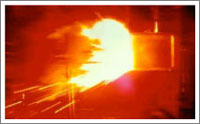|
Arc Flash Hazard Solutions
 Commercial property owners are required by OSHA to provide a workplace safe from electrical hazards. The property owner must ensure that an assessment is performed to determine potential electric hazard exposure for anyone that works on or near energized parts of equipment at their facilities. Commercial property owners are required by OSHA to provide a workplace safe from electrical hazards. The property owner must ensure that an assessment is performed to determine potential electric hazard exposure for anyone that works on or near energized parts of equipment at their facilities.
What is an arc flash?
Arc flash is an electric current that is passed through air when insulation or isolation between electrified conductors is no longer sufficient to withstand the applied voltage. The explosion of concentrated radiant energy is characterized by exceptionally high temperatures, an immense pressure blast, and shrapnel hurling at great speeds.
What causes an arc flash?
An arc flash can be caused by human error including dropped tools, accidental contact with electrical systems, and improper work procedures. In addition, connections that loosen and overheat or dust and water accumulation causing insulation breakdown can also lead to an arc flash incident.
Why conduct an arc flash hazard analysis?
In the U.S. 5 to 10 devastating arc flashes occur daily according to statistics complied by Cap-Schell, Inc., a Chicago based research and consulting firm that specializes in preventing workplace injuries and deaths. Injuries from arc flash events range from minor injuries to third degree burns and potential death due to the energy released. The average cost of medical treatment for survivors of arc flash incidents is $1.5M. Total cost for equipment replacement, repairs, litigation, fines and insurance increases can be $8 – $10M. This does not include the tenants downtime and lost revenue.
What is an arc flash hazard analysis?
An Arc Flash Analysis is an engineering study that determines the amount of current that could flow at any point in an electrical system and the timing required for the nearest circuit protective device to operate to clear a fault.
What are the industry standards that cover electrical arc flash?
OSHA enforces safety practices in the workplace and the following regulations and reference standards are used:
- OSHA 29-CFR, Part 1910 Subpart S
- Standard number 1910.333 workplace safety and reference NFPA70E
- Standard number 1910.335 requires the use of personal protective equipment (PPE) when working where potential electrical hazards exist
- Standard number 1910.132 requires the employer assess the workplace for hazards and the need for PPE
- The National Fire Protection Association (NFPA) Standard 70 - 2017 “The National Electrical Code” (NEC) contains requirements for warning labels
- NFPA 70E-2018 standard for Electrical Safety Requirements for Employee Workplaces
- The Institute of Electronics and Electrical Engineers (IEEE) 1584 – 2002 & 2004 Guide to Performing Arc-Flash Hazard Calculations
What are the arc flash OSHA compliance requirements?
- Provide and be able to demonstrate a safety program with defined responsibilities
- Calculations for the degree of electrical arc flash hazard
- Correct personal protective equipment (PPE) for workers
- Training for workers on the hazards of electrical arc flash
- Appropriate tools for safe working practices and warning labels on equipment
How can Power Management ensure your property is arc flash compliant?
Power Management specializes in arc flash hazard analysis. We coordinate the electrical equipment data collection/analysis, engineering report, label application and the employee training.
Safety is not expensive, it's priceless
|



